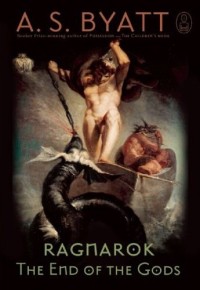Ragnarök: The End of the Gods by A.S. Byatt
 Saturday, February 4, 2012 at 6:41AM
Saturday, February 4, 2012 at 6:41AM 
First published in Great Britain in 2011; published by Grove Press on February 7, 2012
How does something come out of nothing? A thin girl in England during World War II compares creation myths as she ponders the question. Her church teaches her of a "grandfatherly figure" who created everything from the sun to the peacock in six days. Her reading of Asgard and the Gods introduces her to a more appealing explanation. In the empty gulf between the cold mists of the north and the hot flames of the south known as Ginnungagap, a giant named Ymir is formed in the steam of melting icebergs. Ymir becomes the father of "the frost-giants, who budded from his bulk" before he is slaughtered by the first gods: Odin, Wili, and We. The gods make the world from the flesh, blood, and bones of the dismembered giant. Yet nothing lasts forever; even gods must die. Ragnorök refers to the Norse end-times, the judgment of the gods, the twilight of their reign. The gods do not go down gently; as befits a myth, their battle to survive is epic.
The thin girl does not want to consider the possibility that the creation myths are related -- that, for instance, a flood in Asgard might be "an echo of the story of Noah and the Flood" -- because she likes to believe the Asgard stories have an independent foundation. She nonetheless sees similarities between biblical stories and those of Asgard, comparisons that are insightful yet plausibly within the ken of a bright child. The thin girl enjoys but does not believe the stories of Asgard, any more than she believes Greek myths, fairy tales, or the stories told by the vicar at her church. Reading the stories gives her reason to ponder the nature of belief and to ask herself not just why she doesn't believe, but why she doesn't want to believe.
Using the thin girl as a focal point, A.S. Byatt selectively retells the tale of the gods of Asgard from their beginning to their end. Unlike some other entries in the Cannongate/Grove series of books in which contemporary writers reimagine a myth, Byatt does not modernize the myth but uses the character of the thin girl to suggest the ancient tale's relevance to the modern world. The child, familiar with the news of the war that is killing and maiming her countrymen, finds it easy to relate to the brutality of the Norse gods. As the thin girl listens at night to "doom droning in the sky," she imagines Odin's warriors and hunters charging through the heavens. Byatt also analyzes the nature of storytelling as the thin girl anticipates events that are demanded by the conventions of fiction. For instance, a promise that a god will never be harmed assures the opposite: "the shape of the story means that he must be harmed."
The Norse myth of Yggdrasil -- an immense ash tree that is "a world in itself" -- will be familiar to dedicated science fiction fans as the inspiration for various worlds and vessels that share its name. Other familiar figures from the myth include the shapeshifter Loki ("a being who was neither this nor that"), and, of course, the thunder god Thor, complete with hammer. Less familiar (to me) are the goddess Frigg and her not-so-invulnerable son Baldur, whose story illustrates the mischief that gods can make.
Byatt's prismatic prose, sparkling and colorful, transforms the mundane -- mushrooms sprouting near a tree, fish carried by ocean currents -- into something glorious. As lovely as the prose is, however, a few lengthy descriptive sections of the text (particularly those concerning Jörmungandr the snake) are a bit too ponderous. And while Ragnorök: The End of the Gods is a solid and enjoyable retelling of the Norse myth, it is just that: as a retelling rather than a modernization, it offers little that is new, despite the thin girl's apt comparisons of the mythical warriors to the war that rages around her. (In a lengthy essay appended as an afterword, Byatt explains in greater detail than necessary why she wrote the story as she did.)
A final, post-war chapter addressing the thin girl's adjustment to peacetime seems uncomfortably out of place. Still, the retold Norse myths are enough. Norse gods, like nearly all gods, are petty and vengeful, qualities that lend themselves to entertaining drama, as well as lessons about how mere mortals might live richer lives than gods.
RECOMMENDED